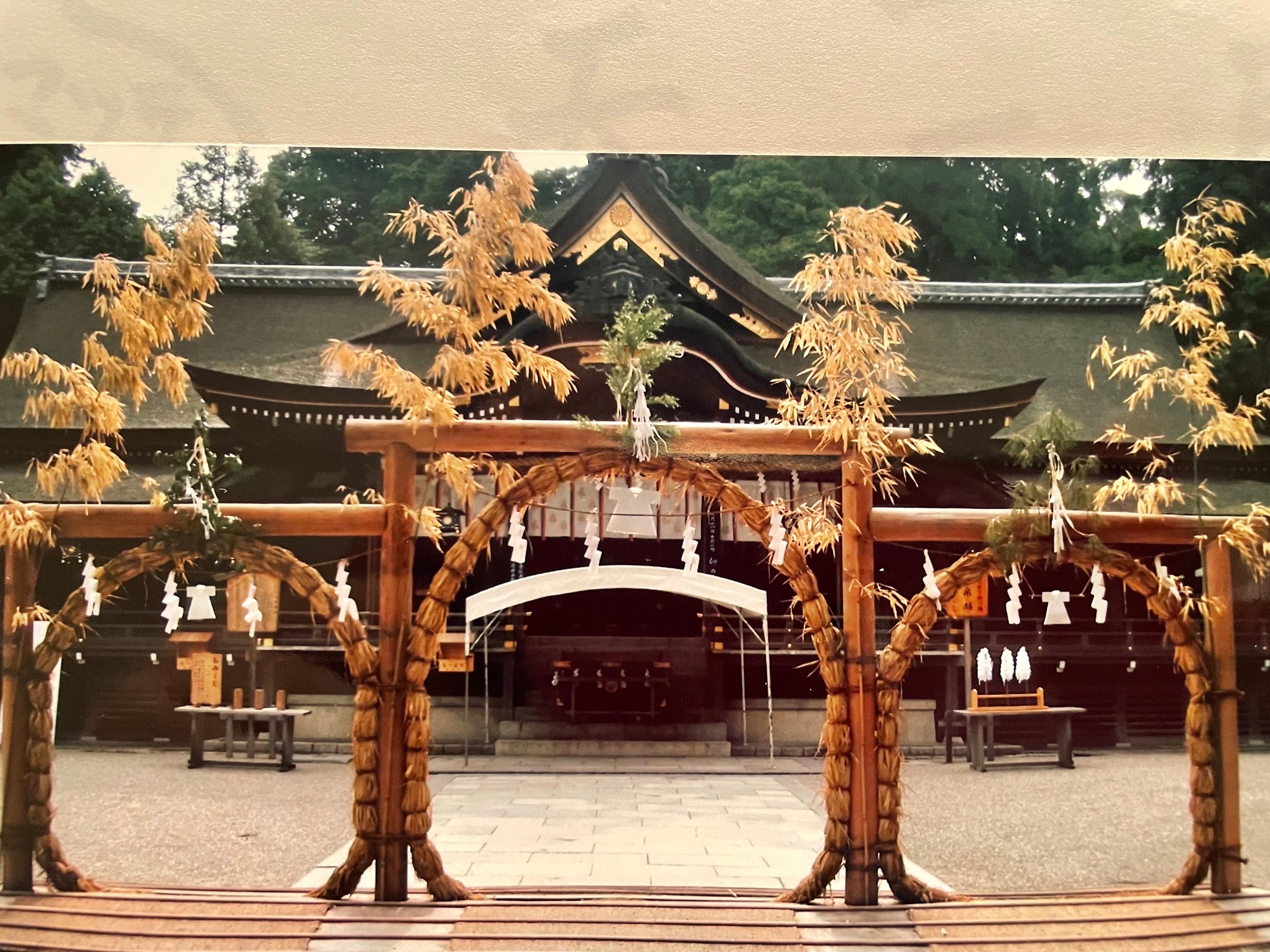三輪山シリーズ#08 「大神神社(おおみわじんじゃ)の茅の輪(ちのわ)」
Do you know about Japanese shrines? Omiwa shrine is one of the oldest shrines in Japan. At 4T-AMKY, Teachers and Students write about Japanese culture, food, history, many spots to visit, and other stuff. Enjoy reading and knowing about deeper Japanese culture!
Mount Miwa#08 ‐Chinowa of Omiwa shrine.
Omiwa shrine on July 1.
I visited Omiwa shrine on July 1, 2022. There were still “Chinowa (rings of cogon grass) ” placed in front of the haiden(worship hall) in the shrine. I was lucky!

Chinowa are rings of braided cogon grass that belongs to the Poaceae family of grasses, which are about a few meters in diameter, and they are used for a Shinto ritual named “Nagoshi-no-oharae”, literally “Summer passing purification ritual” performed on June 30th.

First, I read the directions on how to pass through the Chinowa rings.

Then I passed through them walking like I drew the figure eight.

It is believed that Chinowa rings have spiritual power of purification. When you pass through the Chinowa they remove the sins and vice you have accumulated over the past six months.
Afterwards, I walked to the worship hall and put my hands together and said a silent prayer of thanks in front of it.

Chinowa of Omiwa shrine
If you look at the above photo, you will see three Chinowa rings lined up. Most shrines set up only one Chinowa ring, so this style of Chinowa is very rare and unique to the Omiwa shrine.

The Omiwa shrine also has the unique shape of a sacred torii gate called “Mitsu-torii gate” beyond the Haiden. This is the reason why the chinowa rings of the Omiwa shrine are made of three chinowa rings, in order to resemble the Mitsu-torii gate.

What is Nagoshi-no-oharae?
It is a purification ritual. Often sin and vice attach to people’s bodies and minds in our daily lives without us ever realizing it.
In this ritual people purify themselves from the sin which has been accumulated for the first half of the year by passing through the sacred rings and praying for good health. This ritual is held at many shrines throughout Japan, mostly on June 30.
How long the chinowa are kept in a shrine depends on each shrine. Anyone can walk through this ring during the time when the chinowa are set. According to the website of the Omiwa shrine, the chinowa are placed from the summer solstice through July 7th.
The origin of Chinowa for purification ritual
I tried to find out why people started to pass through Chinowa in this purification ritual. There seem to be various theories, and one of them is as follows.
There is a story of Somin Shorai from The Chronicles of Japan called Bingo Provincial Fudoki.
In ancient times, Muto-no-Kami (also known as Emperor Gozu or Susanoo-no-mikoto) asked the two shorai brothers; Somin-shorai (an elder brother) and Kotan-shorai (a younger brother) if they would let him stay overnight at either of their houses on his journey to marry a bride in the northern part of Japan. Kotan-shorai was rich but he refused. Somin-shorai was poor but offered hospitality and invited him to stay at his place. Muto-no-Kami was grateful to Somin-shorai and gave him chinowa (a ring of cogon grass) and told him to wear the chinowa around his waist in case of an epidemic so that his family can escape the evil of the plague. As a result, descendants of the younger brother failed, and desendants of Somin -shorai continued.
It is said that the origin of passing through the chinowa on the oharae (purification ritual) season is a combination of the above narrative and the ancient Shinto ritual of oharae.
Handing down our cultural tradition
Bingo Provincial Fudoki was compiled in the 8th century. I am deeply impressed by the fact that such an ancient tradition continues today by people in the 21st century. Often so much of our culture comes from ancient tradition that we may have forgotten ever existed.
Memo1: See Mount Miwa#04 about Mitsutorii (triple torii)gate of Omiwa shrine.
Memo2: See “Nagoshi-no-oharae” posted on 2020.10.13 to know more about it.
三輪山シリーズ#08 「大神(おおみわ)神社の茅の輪(ちのわ)」
大神神社参拝
2022年7月1日に大神神社をお参りしました。境内には「茅の輪」がまだ残っていてラッキーでした。
茅の輪は、茅(ちがや)というイネ科の植物で編んだ直径2~3メートルの輪です。6月30日の「夏越(なごし)の大祓(おおはらえ)」の神事に使われます。
くぐり方の説明に従って、∞を描くように茅の輪をくぐりました。
この茅の輪には霊力があり、これをくぐることにより、半年分の穢れが祓われるそうです。
それから拝殿の前で手を合わせ神様に感謝の祈りを捧げました。
大神神社の茅の輪
さて、写真の茅の輪ですが、茅の輪が3つ並んでいる珍しい形をしています。これは大神神社独特のものです。実は、大神神社の拝殿の奥、ご神体の三輪山との境には、全国でも珍しい、鳥居が三つ繋がった「三つ鳥居」があります。それにあわせて、茅の輪も三つ繋がっているのです。
夏越の大祓とは
日々の生活の中で、しらず知らずのうちに心身についた半年分の罪穢れを、霊力のある茅の輪をくぐることによって祓い浄め、無病息災を祈る神事です。日本全国の多くの神社で、多くは6月晦日に行われます。
茅の輪が設置されている期間は神社によって異なるようです。その期間に神社を訪れた参拝者はこの輪をくぐることができます。改めてネットを調べてみたところ、大神神社では、夏至の頃から7月第一週にかけて置かれているようです。
茅の輪くぐりの由来
大祓いに茅の輪くぐりが行われるようになったいわれを調べてみました。
諸説あるようですが、そのひとつをご紹介します。
『備後国風土記(びんごのくにふどき)』に登場する「蘇民将来(そみんしょうらい)の伝説」です。
昔、武塔神(むとうのかみ)という神様(別名、牛頭天皇(ごずてんのう)または須佐之男命(スサノオノミコト))が北国に嫁取りに向かう旅をしていました。その途中で宿に困り、蘇民将来(そみんしょうらい)(兄)と巨旦将来(こたんしょうらい)(弟)に一晩泊めて欲しいと頼みました。巨旦将来はお金持ちなのに断りました。蘇民将来は貧しい暮らしをしていましたが、宿を貸し厚いおもてなしをしました。神様はそれに感謝して、蘇民将来に、もしも疫病が流行ったときには、茅の輪を腰につけておくと逃れられるだろうとお教えになりました。その後その地域に疫病が流行った時に、茅の輪をつけた蘇民将来の家族だけは助かったそうです。
この説話と神道で古来行われていた大祓が一緒になって、大祓の時期に茅の輪くぐりが行われるようになったらしいです。
伝統文化の継承
風土記は8世紀に編纂された地誌です。それに由来した風習を21世紀の私たちがいまも続けていることに深い感銘を覚えます。このように今ではもう忘れられているような古代の伝承から多くの文化が生まれているのかもしれません。
Aki Sawaguchi.
Editor: Stuart Cauley
注1) 大神神社の三つ鳥居については、三輪山シリーズ#04をご覧ください。
注2) 夏越の大祓については、2020.10.13投稿のブログ「夏越の大祓」もどうぞご覧ください。
監修及び表紙の写真提供:大神神社東京分祠代表 根本幸夫先生






